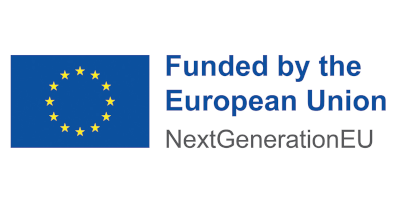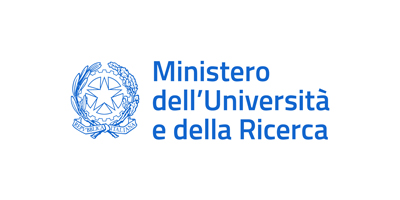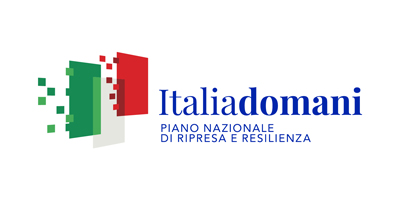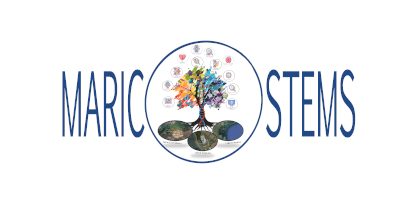Maricostems
Project
Transitional waters include a plethora of different dynamic environments, such as estuarine areas, coastal lagoons, salterns, and salt marshes, showing heterogeneous features. These ecosystems are subject to repeated and sudden variations of several environmental parameters (e.g., pH, temperature, salinity) and sometimes to strong anthropic stress, affecting microbial communities that need a high degree of adaptation. Most of these environments and their "microbial" communities, including the viral component, are underrated, and their chemical and biological diversity is still underestimated.
Thus, these environments deserve to be studied in detail to understand their full ecological role and potential to host pathogens and/or new microbial strains (or neglected species), having unique characteristics exploitable for discovering new bioactive molecules.
In this project, three selected marine transition areas (the "Saline di Tarquinia", non-active saltern; the "Saline Conti Vecchi", active saltern; and the Venice lagoon) will be studied for their microbial (prokaryote and eukaryote) and viral biotas. Although some microbiological studies have previously investigated these sites, to our knowledge, no in-depth metagenomic/metatranscriptomic study is available yet. Thus, in this proposal, the environmental biodiversity will be analyzed to depict its functionality and potential to host possible pathogens or microorganisms that are precious for biotechnological applications (e.g., bioactive molecules).
The studies will be carried out using metagenomic and metatranscriptomic approaches. These approaches will promptly capture the huge genetic variability of the studied communities and advance valuable information to explore their rich biodiversity and functionality. This will permit a deep profiling of the studied communities at taxonomic and functional levels. Hence, it will allow the depiction of the communities and their functions as a whole, but also the fraction expressing the community potential and its ecological role (e.g., biogeochemical cycles). Specific genes related to peculiar metabolic pathways (e.g., biodegradation of recalcitrant compounds) or resistance characters (antibiotics and/or heavy metals) representing important environmental and social issues will also be revealed.
Since the selected environments could represent a reservoir for pathogens harboring also resistance genes, the study will supply a scenario of the actual harmful phenotypes. Nevertheless, these environments represent a rich treasure of hidden microbial diversity with high potential for medical and/or environmental applications. Therefore, the presented molecular biology approaches will help disclose the microbial potential selected by the studied coastal environments.
Overview
The marine ecosystem is enormous and provides many distinct habitats for a wide variety of organisms that are adapted to different special conditions. Among them, coastal hypersaline environments and transitional areas, such as the marine solar salterns and lagoons, represent very interesting study subjects for their peculiar characteristics. They are subject to recurring and sudden (daily/seasonal) variations of some environmental variables (e.g., pH, temperature, salinity, turbidity, nutrients), which are mutually dependent or correlated, generating composite gradients. Due to their location close to human settlements, they could also be subject to strong anthropic impact. All this affects the microbial communities that need a high degree of adaptation.
Salinity is the characterizing parameter of marine salterns constituted by a series of interconnected ponds, creating a broad NaCl gradient starting from the seawater input through various concentrators up to the crystallizers. As demonstrated for other unstable extreme environments, rapid and recurrent temperature and water availability fluctuations submit organisms to great environmental stress, making these sites good models to study some global-change phenomena. Moreover, they represent sources of new microorganisms for possible applications in biotechnology.
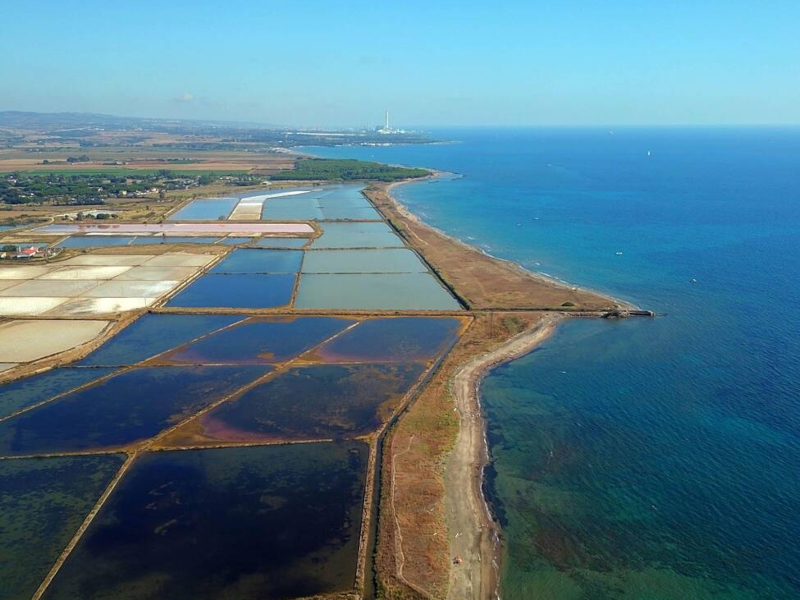
Saline di Tarquinia
The Saline di Tarquinia (ST) are marine salterns located in Tarquinia (Viterbo, Italy), approximately 80 km northwest of Rome. They cover an area of about 135 ha along the Lazio coastline of the northern Tyrrhenian Sea. The ST area has been used for salt extraction since the Villanovan period (10 th -8 th century BC), even before the establishment of the Etruscan civilization. These salterns were built following Pope Pius VI request and they have been operating since 1805. As a result of the conversion into a Nature Reserve (DM 25/01/1980), starting from 1980 the ST were subject to environmental protection and intended for wildlife repopulation. Since 1995, the ST have been recognized as “Sito di Importanza Comunitaria” (SIC IT6001025) and a “Zona a Protezione Speciale” (ZPS IT6001026). In addition, they have been included within the Natura 2000 network (Directives 92/43/EEC and 79/409/EEC). The salt production was dismissed in 1997 and the ST remain a non-productive salterns.
Apart from an early work (1990) dealing with the ST microalgal flora, a more systematic study on the microbial ST communities started in 2010. Few studies regarded the presence and characterization of phytoplanktonic microorganisms. The research activities (carried out by the Laboratory of Microbiology, Department of Ecological and Biological Sciences, University of Tuscia, Viterbo, Italy) focused also on the characterization of the ST bacterial communities, performed using both culture-dependent and culture-independent methods. However, no metagenomic or metatranscriptomic studies have been carried out on the ST prokaryotic communities, while the viral diversity of this environment remains completely unknown.
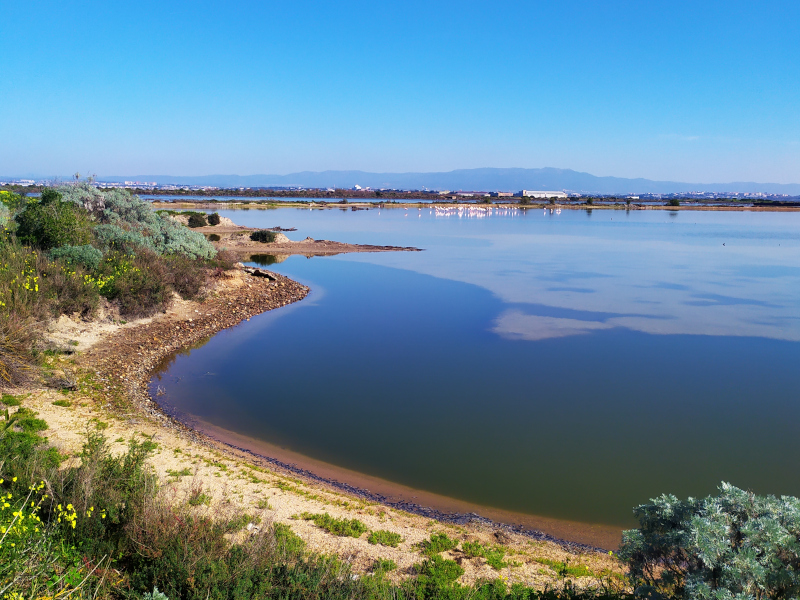
Saline Conti Vecchi
The “Saline Conti Vecchi" (CV) covers ~2700 ha and is located within the Santa Gilla lagoon (Sardinia's southern coast) on the outskirts of Cagliari. They are the 2nd largest and the long-established Italian saltworks, founded in the late 1920s by the reclaim of the area, with an important historical contribution to the development of this depressed and malarial zone. Then, a flourishing "salt community" arose, with an increased anthropic presence that today includes the nearby industrial area of "Macchiareddu".
In 1984, a project of industrial regeneration and environmental redevelopment started, leading in 2017 to the entrustment to the Italian National Trust for historical, artistic and landscape heritage. Today, CV produces 400,000 tons of salt yearly and includes 250 flats within a natural oasis hosting great colonies of water birds, including a permanent colony of thousands of flamingos.
While a number of works were dedicated to the macroscopic effects of pollution in the Santa Gilla lagoon, which has been heavily contaminated by industrial discharges for decades, the microbial and viral diversity of this area (including that of the CV saltworks) remains uncharacterized.
Lagoon of Venice
A lagoon is a shallow body of water separated from a larger body of water by a narrow landform. Coastal lagoons support a range of natural services highly valued by society. The Lagoon of Venice is one of the largest coastal-transitional ecosystems of the Mediterranean Sea. Three inlets allow connection with the sea. It includes relevant urban centers, industrial districts, and zootechnical and agricultural activities. It is a unique, complex ecosystem that several anthropogenic stressors have long impacted.
In recent years, Venice suffered from the environmental effects of over-tourism, considering that the historic town center lacks modern and efficient sewage treatment due to Venice's history and unique architecture. Consequently, untreated or partially treated sewage is continuously discharged directly into the canals, adding to commercial effluents.
Several studies carried out in the Venice lagoon have shown the presence of a wide range of contaminants, including heavy metals, hydrocarbons and other harmful xenobiotics. Based on these data and the relative hazard quotients, the lagoon could be divided into four geographical sub-basins: north, central-north, central and south. Although some studies investigated the microbial diversity within the Venice Lagoon, no study has investigated the functional diversity of these microbial communities.
Work packages
This WP is aimed at obtaining the study materials for the subsequent WPs. Both waters and sediments from the selected marine coastal environments will be sampled and subject to DNA and RNA extraction for the metagenomic and metatranscriptomic studies. Sampling will possibly be done (depending on the project's beginning) during two seasons characterized by very different climate conditions and anthropic impact (e.g., winter and summer) when significant differences in microbial community pattern will be expected. As for the two salterns, samples will be collected from the adjacent coastal area, representing the seawater input of the saltern, and from three ponds (low- and intermediate-salinity concentrators and a crystallizer) selected to cover the whole salinity gradient. As for the VL, based on the studies and risk assessment screenings performed to evaluate sediment quality, samples will be collected from four selected geographical sub-basins: north, central-north, central and south. According to international sediment quality guidelines, these areas have been identified during a 25-year-long survey monitoring and determining the relative hazard quotients for each contaminant.
This WP aims to obtain metagenomic data to investigate the composition and functional traits of microbial communities and DNA viruses harbored by the selected sampling sites.
Metabarcoding analyses will be used to provide more detailed taxonomic information on the microbial communities when necessary.
This WP aims to obtain metatranscriptomic data, revealing the active members of the microbial communities and their functional activity. For viruses, the metatranscriptomic approach would allow the precise identification of the RNA viruses within the sampling sites. Metagenomic studies are biased towards detecting DNA viruses even if, theoretically, metagenomic studies could determine all viruses present in a sample due to the constraints of sample preparation and sequencing techniques.
Search for the genes expressing secondary metabolites (SM) and/or resistance to antibiotics or metals (RG) will be carried out by gene mining both on the whole genomes and the transcriptomes obtained in the previous WPs. Starting from the microbial functional annotation, an in-silico gene mining approach will be used to search for the putative genes involved in the biosynthesis of secondary metabolites of interest (e.g., antibiotics, toxins), in xenobiotic biodegradation and antibiotic and metal resistance.
We will look for several pathways of interest involved in xenobiotic metabolization. Such pathways will include the degradation of pesticides (e.g., atrazine), hydrocarbons and petroleum, or dioxin, among others.
We will also look for pathways involved in the degradation and metabolization of antibiotics (e.g., beta-lactamases, cationic antimicrobial peptides) and reduction of heavy metals (e.g., arsenic, cadmium, copper, lead, mercury) toxicity.
In addition to the catabolic pathways, we will also look for genes involved in the biosynthesis of SM with biotechnological implications, such as antibiotics and degradation of chitin, cellulose and other bio-polymers.
For our search, we will rely on specialized databases. However, we will also implement a machine-learning pipeline to look for unknown functions using computational approaches to detect hidden biosynthetic potential.
As for the fungal genes, metagenomes and metatranscriptomes will be screened, targeting those involved in the secondary metabolism. The main classes of fungal SMs are non-ribosomal peptides, amino and fatty acid-derived compounds, polyketides and terpenes. Their biosynthesis relies on key enzymes: Non-Ribosomal Peptide Synthetases (NRPS), PolyKetide Synthases (PKS) and Terpene Synthases (TS), respectively. The metabolites synthesized by these enzymes display a vast chemical diversity, reflecting their broad spectrum of bioactivities used in pharmaceutical research as antimicrobial or anticancer molecules. As for bacterial antibiotic resistance, the search will be focused on some of the most interesting genes for antibiotic resistance, such as the mecA (leading to high-level resistance to methicillin and other β-lactam antibiotics, in the multi-resistant Staphylococcus aureus), the penA (found in penicillin-resistant Neisseria meningitides), the van genes (Enterobacterium spp.). As for the heavy metal resistance, the focus will be given, for example, to mer genes (responsible for the mercury resistance), act and cop genes (involved in copper resistance), As resistance gene ars and pst genes (resistance to arsenic), and pbr genes (resistance to lead). The biodegradation genes mined will be, for example, the bph and ppah genes (biodegradation of a number of aromatics including naphthalene and dioxin), the mmo and alk genes (aliphatic, alicyclic and aromatic hydrocarbons), ppo (for expression of polyphenol oxidases and laccases involved in degradation of various natural and xenobiotic aromatics).
In addition, the search for viral genetic elements within the microbial metagenomes will be carried out. Viral metagenomic analysis can give indirect clues about the potential microorganisms that host virus replication by analyzing the Clusters of Regularly Interspaced Short Palindromic Repeats (CRISPR) loci from the bacterial fraction of the metagenomes.
Events
- 3/09/2025 - MICROTRANSEAS 2025
1st international workshop “Microbial Diversity and Functioning in Marine and Transition Environments”
Team
The project involves 3 Research Units (RU) coordinated by RU 1.

Research Unit 1
led by Dr. Susanna Gorrasi
The Research Unit of the University of Tuscia is affiliated with the Laboratory of Microbiology at the Department of Ecological and Biological Sciences. The RU has expertise in studying microbial diversity (particularly that of marine extreme environments) through culture-dependent and culture-independent methods, including next-generation sequencing and related bioinformatic analyses.

Research Unit 2
led by Dr. Nicole Grandi
The Research Unit, represented by the Laboratory of Molecular Virology of the University of Cagliari [ITA], has sound expertise in the study of viral biology and virus-host interactions through the combination of traditional wet lab techniques, next generation sequencing, and bioinformatics. The Unit is led by Dr. Nicole Grandi and will rely on a young researcher to be enrolled within the project and on different collaborations.

Research Unit 3
led by Dr. Marco Picone from 01/02/2024, by Dr. Bessem Chouaia until 31/03/2024
The Research Unit, represented by the Laboratory of Microbial Ecology and Evolution from Ca’ Foscari University of Venice, has sound expertise in the different aspects of microbial ecology and the study of microbial interactions in different systems. The RU also has good expertise in combining traditional wet lab tools, next-generation sequencing, and bioinformatics to study these systems. The Unit is led by Dr. Bessem Chouaia and will rely on a young researcher to be enrolled within the project and on different collaborations.

